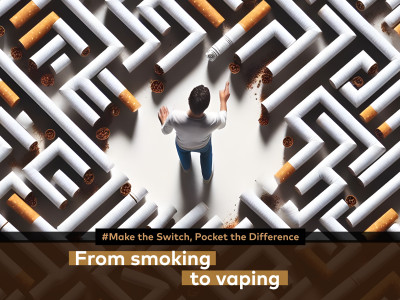Professor Ross Lawrenson, a Professor in Population Health at the University of Waikato, takes a de facto position that vaping is dangerous when he pleaded for more evidence of its harms. “So far we do not have any evidence that vaping does cause cancer,” he said. “The paper does not provide sufficient evidence of harmful outcomes that will be needed before the public will be convinced to stop.”
Dr Ian Walker, Cancer Research UK’s executive director of policy, takes a more measured look: “This study contributes to our understanding of e-cigarettes, but it does not show that e-cigarettes cause cancer. Decades of research has proven the link between smoking and cancer, and studies have so far shown that e-cigarettes are far less harmful than smoking and can help people quit. This paper does however highlight that e-cigarettes are not risk-free, and so we need additional studies to uncover their potential longer-term impacts on human health.”
Professor Peter Shields, Emeritus Professor of Medical Oncology at the Ohio State University, offered words of caution, pointing out that though the journal Cancer Research is a “really high quality journal”, the study (in his opinion) does not lead to the conclusions the authors claim. Shields said there was “a substantial weakness for their smoking/vaping analysis”.
Professor Shields continued: “The authors report novel data but there are substantial limitations that are not mentioned in the manuscript. They did their best to find suitable cohorts to study, but the problem is that they are combining very disparate types of study sets and so do not know what confounding they have. To understand the overlap, they needed to show the results from each set for smokers, and then one for the vapers, smokers and never-smokers – without that, it is just impossible to visualize the overlap.
“To make their claims of adverse effects, there are critical pieces of information that are missing. They do not have good vaping/smoking data so mostly rely on each person saying yes/no, or self-reporting years of use. This is very crude and without the dose-response assessment (e.g., packs per day, vapes per day, etc), they are still a far distance from being able to show causality. For the vapers, there was no biochemical verification that they were actually not also smokers.
“The crucial question is not whether vaping has epigenetic changes (which we cannot say establish a risky cell type or a physiological protective mechanism to prevent disease) – but how do vapers compare to smokers and never-smokers. They really do not explore that well, but in fact the data looks like vapers are actually more like never-smokers – implying their risk of cancer is not increased by vaping! This is not discussed. The authors really need to be more cautious.”
Lastly, Associate Professor George Laking, the Director of the Centre for Cancer Research at the University of Auckland, cautioned that, “framing is everything in discussions of risk.”
Associate Professor Laking said: “The authors of this study write that ‘despite widespread endorsement by Public Health England, who have advocated e-cigarettes as ‘95% less harmful’ than combustible cigarettes, recent studies have highlighted potential drawbacks’. A finding of drawbacks would not in itself be a ‘despite’ – it can still be compatible with the ‘95% less harmful’ figure, that also means ‘5% harmful’.
He continued: “The paper finds that users of e-cigarettes had more hypermethylation in cells lining their cheeks, compared with never-smokers. They say at least some of these changes were ‘similar’ to those seen in smokers. One should beware of the word ‘similar’, as it can have a lot of different meanings. For example, a lethal snake is in some ways ‘similar’ to a harmless earthworm. It’s important to highlight there were other changes in the cells of smokers that weren’t seen in e-cigarette users or non-smokers.
“The development of cancer is a multi-step process. In this study an early step appears to be at play in users of e-cigarettes. I don’t see this as especially new information, when viewed alongside reports about inflammatory changes in tissues of e-cigarette users. Cellular and tissue mechanisms of repair and cancer control exist, which can counter the effects of such changes.
“Overall, this paper should not change the basic public health messages of ‘Vaping to Quit.’ Vaping remains an essential tool for harm reduction compared to cigarettes. The question with harm reduction is always ‘by how much is the harm reduced?’ Although that is a question a lot of people are working on (including all the people who vape!), it is not a question this study can answer.”
Photo Credit:
Photo by National Cancer Institute on Unsplash
Dave Cross
Journalist at POTVDave is a freelance writer; with articles on music, motorbikes, football, pop-science, vaping and tobacco harm reduction in Sounds, Melody Maker, UBG, AWoL, Bike, When Saturday Comes, Vape News Magazine, and syndicated across the Johnston Press group. He was published in an anthology of “Greatest Football Writing”, but still believes this was a mistake. Dave contributes sketches to comedy shows and used to co-host a radio sketch show. He’s worked with numerous vape companies to develop content for their websites.
Join the discussion
Parliament Fears Two
The Department for Environment, Food and Rural Affairs faced questions from a Conservative MP and, oddly, a member of the Department for Environment, Food and Rural Affairs
Harm Reduction For The Rich
The United Kingdom risks becoming a harm reduction country only for the wealthy, according to Michael Landl of the World Vapers’ Alliance
Sacrificing Health For 2p Cut
Tory Government alienates vaping voters with its mission to cut tax by an unaffordable 2p to attract voters by placing a tax on vape products in the forthcoming budget
CAPHRA Highlights Tobacco Control Flaws
The Coalition of Asia Pacific Tobacco Harm Reduction Advocates highlights the flaws in tobacco control which has led to the rise of black market in Australia












